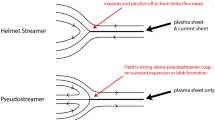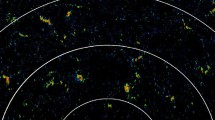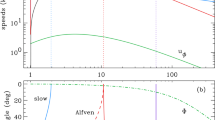Abstract
Ulysses is traversing the Sun's polar regions for the first time a year or two before solar minimum. If the heliospheric magnetic field behaves as we expect, the heliospheric current sheet (HCS) during this stage of the sunspot cycle should be quite stable and lie nearly flat, close to the equator. The high latitude solar fields should be unipolar and nearing their maximum strength. The overlying polar coronal holes should be well developed, producing a nearly uniform high-speed solar wind. Because the Sun's polar fields liver longer than any other solar magnetic phenomenon, Ulysses will remain within a single coronal hole for an extended period and probe its structures in a unique way.
Of course everything will almost certainly not turn out to be as quiet and well-ordered as we expect. We know now that the photospheric field strength in the northern polar cap is less than the south. What will this mean for the solar wind speed and the magnitude of the interplanetary magnetic field? Solar and coronal observations suggest that the first magnetic signatures of the next solar cycle may already be emerging at high latitudes. Will Ulysses sense these fields “leaking” into the heliosphere or is the interplanetary magnetic structure completely dominated by the large-scale field as the models currently predict? How will the sources of variations in field, velocity, density, and composition fit into our conceptual picture?
Ulysses' rapid dash from south to north provides a unique opportunity to determine the latitudinal width of the equatorial region influenced by the HCS. This rapid change in latitude over a short interval during which the structure should be stable, should provide a definitive measurement of the latitudinal gradients of various quantities relative to the heliomagnetic equator.
In the next several years Ulysses will gradually decrease in latitude, eventually meeting the HCS as it gradually expands away from the equator during the rising part of the cycle. It will then race the HCS to the poles as maximum approaches. The situation in six years, at solar maximum, will be radically different. There will be no unipolar high latitude field, the HCS will extend to the poles, existing structures will be less stable, and there will likely even be multiple current sheets. Ulysses will have another opportunity to confirm or disprove our understanding of the high latitude heliosphere in a much different environment. The extended mission is essential to advance our understanding of the heliospheric field at the extremes of the solar cycle.
Similar content being viewed by others
References
Altrock, R.C.: 1988, ‘Variation of Solar Coronal Fe XIV 5303A Emission During Solar Cycle 21’, in R.C. Altrock, ed(s).,Solar and Stellar Coronal Structure and Dynamics, NSO/Sacramento Peak: Sunsport, New Mexico, 414.
Altschuler, M.D. and Newkirk, G. Jr.: 1969, ‘Magnetic Fields and the Structure of the Solar Corona’,Solar Phys. 9, 131.
Balogh, A., Erdos, G., Forsyth, R.J., and Smith, E.J.: 1993, ‘The Evolution of the Interplanetary Sector Structure in 1992’,Geophys. Res. L. 20, 2331.
Behannon, K.W., Burlaga, L.F., Hoeksema, J.T., and Klein, L.W.: 1989, ‘Spatial Variation and Evolution of Heliosphere Sector Structure’,J. Geophys. Res. 94, 1245.
Bogdan, T.J. and Low, B.C.: 1986, ‘The Three-Dimensional Structure of Magnetostatic Atmospheres II. Modeling the Large-scale Corona’,Astrophys. J. 306, 271.
Bruno, R., Burlaga, L.F., and Hundhausen, A.J.: 1984, ‘K-Coronameter Observations and Potential Field Model Comparison in 1976 and 1977’,J. Geophys. Res. 89, 5381.
Farnham, T.L. and Meech, K.J.: 1994, ‘Comparison of the Plasma Tails of Four Comets: P/Halley, Okazaki-Levy-Rudenko, Austin, and Levy’,Astrophys. J. 91, 419.
Gazis, P.R., Mihalov, J.D., Barnes, A., and Lazarus, A.J., and Smith, E.J.: 1989, ‘Pioneer and Voyager Observations of the Solar Wind at Large Heliocentric Distances and Latitudes’,Geophys. Res. Let. 16, 223.
Harvey, K.L.: 1992, ‘The Cyclic Behavior of Solar Activity’ in K. harvey, ed(s).,The Solar Cycle, A.S.P. Conf. Proc. 27: San Francisco, CA, 335.
Hoeksema, J.T., and Scherrer, P.H.: 1987, ‘Rotation of the Coronal Magnetic Field’,Astrophys. J. 318, 428.
Hoeksema, J.T., Wilcox, J.M., and Scherrer, P.H.: 1982, ‘Structure of the Heliospheric Current Sheet in the Early Portion of Sunspot Cycle 21’,J. Geophys. Res. 87, 10331.
Hoeksema, J.T., Wilcox, J.M., and Scherrer, P.H.: 1983, ‘The Structure of the Heliospheric Current Sheet: 1978–1982’,J. Geophys. Res. 88, 9910.
Levine, R.H.: 1982, ‘Open Magnetic Fields and the Solar Cycles, I’,Solar Phys 79, 203.
Niedner, M.B. and Brandt, J.C.: 1978, ‘Interplanetary Gas XXIII: Plasma Tail Disconnection Events in Comets: Evidence for Magnetic Field Line Reconnection at Interplanetary Sector Boundaries?’,Astrophys. J. 223, 655.
Phillips, J.L., Balogh, A., Bame, S.J., Goldstein, B.E., Gosling, J.T., Hoeksema, J.T., McComas, D.J., Neugebauer, M., Sheeley, N.R., and Wang, Y.-M.: 1994, ‘Ulysses at 50°S: Constant Immersion in the High-speed Solar Wind’,Geophys. Res. L., in press.
Schatten, K.H.: 1971, ‘Current Sheet Magnetic Model for the Solar Corona’,Cosmic Electrodynamics 2, 232.
Schatten, K.H., Wilcox, J.M., and Ness, N.F.: 1969, ‘A Model of Interplanetary and Coronal Magnetic Fields’,Solar Phys 6, 442.
Sheeley, N.R. Jr., Wang, Y.-M., and Phillips, J.L.,: 1994, ‘Near-Sun Magnetic Fields and the High-Latitude Solar Wind’,Space Sci. Rev., this volume.
Sime, D.G., and McCabe, M.K.: 1990, ‘The Structure of the White-light Corona and the Large-scale Solar Magnetic Field’,Solar Phys 126, 267.
Smith, E.J., Neugebauer, M., Balogh, A., Bame, S.J., Erdos, G., Forsyth, R.J., Goldstein, B.E., Phillips, J.L., and Tsurutani, B.T.: 1993, ‘Disappearance of the Heliospheric Sector Structure at Ulysses’,Geophys. Res. Lett. 20, 2327.
Smith, E.J., Tsurutani, B.T., and Rosenberg, R.L.: 1978, ‘Observations of the Interplanetary Sector Structure up to Heliographic Latitudes of 16°: Pioneer 11’,J. Geophys. Res. 83, 717.
Suess, S.T., McComas, D.J. and Hoeksema, J.T.: 1993, ‘Prediction of Heliospheric Current Sheet Tilt: 1992–1996’,Geophys. Res. L. 20, 161.
Svalgaard, L., Duvall, T.L. Jr., and Scherrer, P.H.: 1978, ‘The Strength of the Sun's Polar Fields’,Solar Phys 58, 225.
Wang, Y.-M.: 1994, ‘Latitude and Solar-Cycle Dependence of Radial IMF Intensity’,Space Sci. Rev, this volume.
Wang, Y.-M., and Sheeley, N.R. Jr.: 1990, ‘Magnetic Flux Transport and the Sunspot-Cycle Evolution of Coronal Holes and Their Wind Streams’,Astrophys. J. 365, 372.
Wang, Y.-M., and Sheeley, N.R., Jr.: 1991, ‘Why Fast Solar Wind Originates from Slowly Expanding Coronal Flux Tubes’,Astrophys. J.,372, L45.
Wang, Y.-M., and Sheeley, N.R. Jr.: 1992, ‘On Potential Field Models of the Solar Corona’,Astrophys. J. 392, 310.
Wilcox, J.M., and Hundhausen, A.J.: 1983, ‘Comparison of Heliospheric Current Sheet Structure Obtained from Potential Magnetic Field Computations and from Observed Maximum Coronal Brightness’,J. Geophys. Res. 88, 8095.
Wolfson, R.: 1985, ‘A Coronal Magnetic Field Model with Volume and Sheet Currents’,Astrophys. J. 288, 769.
Zhao, X.P. and Hoeksema, J.T.: 1994a, ‘Prediction of the Interplanetary Magnetic Field Strength’,Space Sci. Rev, this volume.
Zhao, X.P. and Hoeksema, J.T.: 1994b, ‘Prediction of the Interplanetary Magnetic Field’,J. Geophys. Res., submitted.
Author information
Authors and Affiliations
Rights and permissions
About this article
Cite this article
Hoeksema, J.T. The large-scale structure of the heliospheric current sheet during the Ulysses epoch. Space Sci Rev 72, 137–148 (1995). https://doi.org/10.1007/BF00768770
Received:
Issue Date:
DOI: https://doi.org/10.1007/BF00768770




